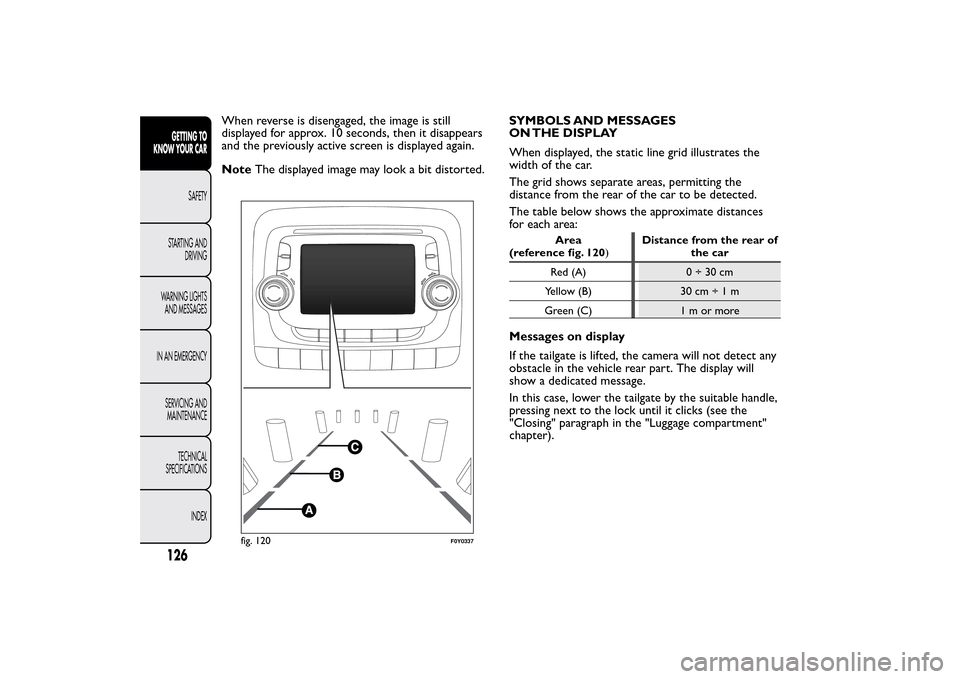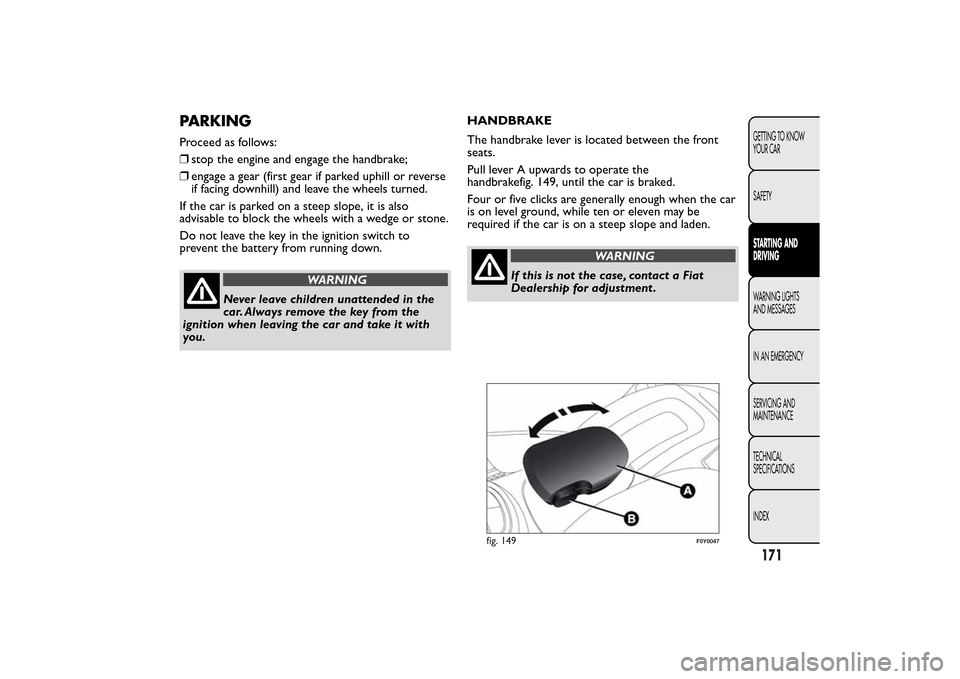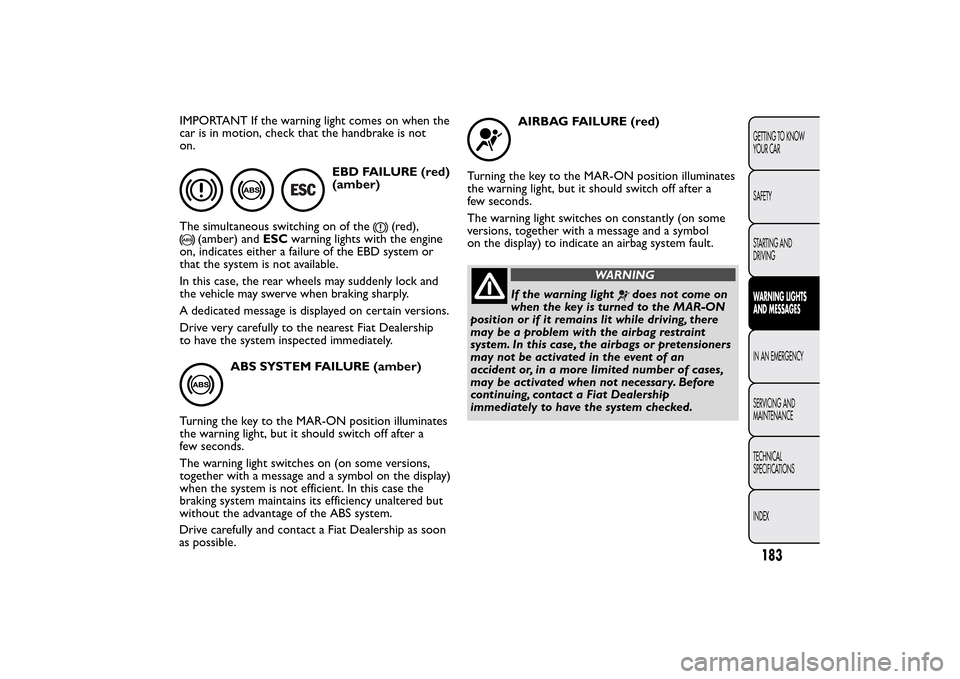Page 130 of 420

When reverse is disengaged, the image is still
displayed for approx. 10 seconds, then it disappears
and the previously active screen is displayed again.
NoteThe displayed image may look a bit distorted.SYMBOLS AND MESSAGES
ON THE DISPLAY
When displayed, the static line grid illustrates the
width of the car.
The grid shows separate areas, permitting the
distance from the rear of the car to be detected.
The table below shows the approximate distances
foreacharea:
Area
(reference fig. 120)Distance from the rear of
the car
Red(A) 0÷30cm
Yellow (B) 30 cm÷1m
Green (C) 1 m or more
Messages on display
If the tailgate is lifted, the camera will not detect any
obstacle in the vehicle rear part. The display will
show a dedicated message.
In this case, lower the tailgate by the suitable handle,
pressing next to the lock until it clicks (see the
"Closing" paragraph in the "Luggage compartment"
chapter).
fig. 120
F0Y0337
126GETTING TO
KNOW YOUR CAR
SAFETY
STARTING AND
DRIVING
WARNING LIGHTS
AND MESSAGES
IN AN EMERGENCY
SERVICING AND
MAINTENANCE
TECHNICAL
SPECIFICATIONS
INDEX
Page 133 of 420

When the CITY function is on, the steering wheel
effort is lighter, parking operations are easier:
therefore this function is particularly useful for
driving in city centres.
WARNING
It is absolutely forbidden to carr y out
any after-market operation involving
steering system or steering column
modifications (e.g.: installation of anti-theft
device) that could badly affect performance and
safety, invalidate warranty and also result in
non-compliance of the car with type approval
requirements.
IMPORTANT During parking manoeuvres requiring a
lot of steering, the steering may become harder;
this is normal and is due to the intervention of the
system to protect the electric steering motor from
overheating. No repair intervention is needed in this
case. When the car is used again, the power steering
will work normally again.
WARNING
Before performing any maintenance
operations, always turn off the engine
and remove the key from the ignition to lock
the steering column (especially when the car
wheels are not touching the ground). If this
is not possible (for example if the key needs to
be turned to MAR-ON or the engine must be
running), remove the main fuse that protects
the electric power steering.
129GETTING TO
KNOW YOUR CARSAFETY
STARTING AND
DRIVING
WARNING LIGHTS
AND MESSAGES
IN AN EMERGENCY
SERVICING AND
MAINTENANCE
TECHNICAL
SPECIFICATIONS
INDEX
Page 145 of 420

SAFETY
SEAT BELTSUSING THE SEAT BELTS
The seat belt should be worn keeping the torso
straight and rested against the backrest.
To fasten the seat belts, hold the tongue A fig. 131
and insert it into the buckle B, until it clicks into
place.
If the seat belt jams during removal, let it rewind for
a short stretch, then pull it out again without jerking.
To unfasten the seat belt, press button C. Guide
the seat belt while it is rewinding, to prevent it from
twisting. Through the retractor, the belt
automatically adapts to the body of the occupant
wearing it, allowing freedom of movement.
WARNING
Never press button C fig. 131 when
travelling.
The retractor may lock when the car is parked on a
steep slope: this is normal. Furthermore, the
retractor mechanism locks the belt if it is pulled
sharply or in the event of sudden braking, collisions
or high-speed bends.
The rear seat is fitted with inertial seat belts with
three anchor points and a retractor. Wear the rear
seat belts as shown in fig. 132.
fig. 131
F0Y0085
fig. 132
F0Y0086
141GETTING TO KNOW
YOUR CARSAFETYSTARTING AND
DRIVING
WARNING LIGHTS
AND MESSAGES
IN AN EMERGENCY
SERVICING AND
MAINTENANCE
TECHNICAL
SPECIFICATIONS
INDEX
Page 175 of 420

PARKINGProceed as follows:
❒stop the engine and engage the handbrake;
❒engage a gear (first gear if parked uphill or reverse
if facing downhill) and leave the wheels turned.
If the car is parked on a steep slope, it is also
advisable to block the wheels with a wedge or stone.
Do not leave the key in the ignition switch to
prevent the battery from running down.
WARNING
Never leave children unattended in the
car. Always remove the key from the
ignition when leaving the car and take it with
you.HANDBRAKE
The handbrake lever is located between the front
seats.
Pull lever A upwards to operate the
handbrakefig. 149, until the car is braked.
Four or five clicks are generally enough when the car
is on level ground, while ten or eleven may be
required if the car is on a steep slope and laden.
WARNING
If this is not the case, contact a Fiat
Dealership for adjustment .
fig. 149
F0Y0047
171GETTING TO KNOW
YOUR CAR
SAFETYSTARTING AND
DRIVINGWARNING LIGHTS
AND MESSAGES
IN AN EMERGENCY
SERVICING AND
MAINTENANCE
TECHNICAL
SPECIFICATIONS
INDEX
Page 187 of 420

IMPORTANT If the warning light comes on when the
car is in motion, check that the handbrake is not
on.
EBD FAILURE (red)
(amber)
The simultaneous switching on of the
(red),
(amber) andESCwarning lights with the engine
on, indicates either a failure of the EBD system or
that the system is not available.
In this case, the rear wheels may suddenly lock and
the vehicle may swerve when braking sharply.
A dedicated message is displayed on certain versions.
Drive very carefully to the nearest Fiat Dealership
to have the system inspected immediately.
ABS SYSTEM FAILURE (amber)
Turning the key to the MAR-ON position illuminates
the warning light, but it should switch off after a
few seconds.
The warning light switches on (on some versions,
together with a message and a symbol on the display)
when the system is not efficient. In this case the
braking system maintains its efficiency unaltered but
without the advantage of the ABS system.
Drive carefully and contact a Fiat Dealership as soon
as possible.
AIRBAG FAILURE (red)
Turning the key to the MAR-ON position illuminates
the warning light, but it should switch off after a
few seconds.
The warning light switches on constantly (on some
versions, together with a message and a symbol
on the display) to indicate an airbag system fault.
WARNING
If the warning light
does not come on
when the key is turned to the MAR-ON
position or if it remains lit while driving, there
may be a problem with the airbag restraint
system. In this case, the airbags or pretensioners
may not be activated in the event of an
accident or, in a more limited number of cases,
may be activated when not necessary. Before
continuing, contact a Fiat Dealership
immediately to have the system checked.
183GETTING TO KNOW
YOUR CAR
SAFETY
STARTING AND
DRIVINGWARNING LIGHTS
AND MESSAGESIN AN EMERGENCY
SERVICING AND
MAINTENANCE
TECHNICAL
SPECIFICATIONS
INDEX
Page 203 of 420

JACK
Please note that:
❒the jack weight is 1,76 kg;
❒the jack requires no adjustment;
❒the jack cannot be repaired and in the event of a
fault it must be replaced by another original one;
❒no tool other than its cranking device may be
fitted on the jack.
To change a wheel, proceed as follows:
❒Stop the car in a position that is not dangerous for
oncoming traffic where you can change the wheel
safely. The ground must be flat and sufficiently
compact;
❒switch off the engine, pull up the handbrake and
engage the 1
stgear or reverse. Wear the reflective
safety jacket (compulsory by law) before getting
out of the car;
❒open the luggage compartment, pull tab A fig. 154
and lift up the mat B;❒using the wrench A fig. 155 located in the tool
box, loosen the locking device, take the tool box B
and place it close to the wheel to be replaced.
Then take the space-saver wheel C;
fig. 154
F0Y0083
fig. 155
F0Y0096
199GETTING TO KNOW
YOUR CAR
SAFETY
STARTING AND
DRIVING
WARNING LIGHTS
AND MESSAGESIN AN
EMERGENCYSERVICING AND
MAINTENANCE
TECHNICAL
SPECIFICATIONS
INDEX
Page 212 of 420
CHECKING AND RESTORING TYRE
PRESSURE
The compressor can also be used to check and, if
necessary, adjust the tyre pressure. Release quick
connector A fig. 16 and connect it directly to the
valve of the tyre to be inflated.REPLACING THE BOTTLE
Proceed as follows:
❒disconnect connection A fig. 169;
❒turn the cylinder to be replaced anticlockwise and
raise it;
❒fit the new cylinder and turn it clockwise;
❒connect connection A to the cylinder and insert
the transparent pipe B into its housing.
fig. 168
F0Y0008
fig. 169
F0Y0007
208GETTING TO KNOW
YOUR CAR
SAFETY
STARTING AND
DRIVING
WARNING LIGHTS
AND MESSAGES
IN AN
EMERGENCY
SERVICING AND
MAINTENANCE
TECHNICAL
SPECIFICATIONS
INDEX
8
Page 214 of 420
TYPES OF BULBSVarious types of bulbs are fitted to your car:
All-glass bulbs:(type A) press-fitted. Pull to remove.Bayonet type bulbs:(type B) to remove them press the
bulb and turn it anticlockwise.
Tubular bulbs:(type C) release them from their contacts
to remove.
Halogen bulbs:(type D) to remove the bulb, release the
clip holding the bulb in place.
Halogen bulbs:(type E) to remove the bulb, release the
clip holding the bulb in place.
210GETTING TO KNOW
YOUR CAR
SAFETY
STARTING AND
DRIVING
WARNING LIGHTS
AND MESSAGES
IN AN
EMERGENCY
SERVICING AND
MAINTENANCE
TECHNICAL
SPECIFICATIONS
INDEX